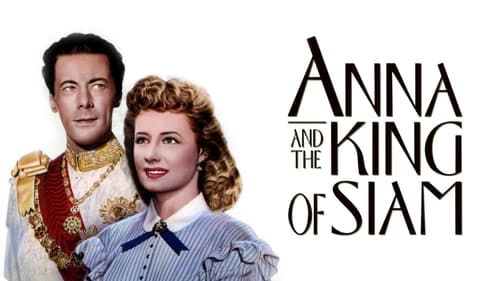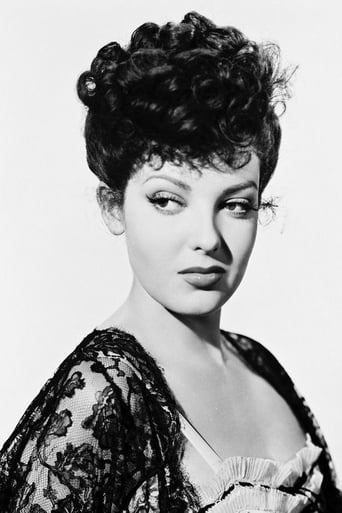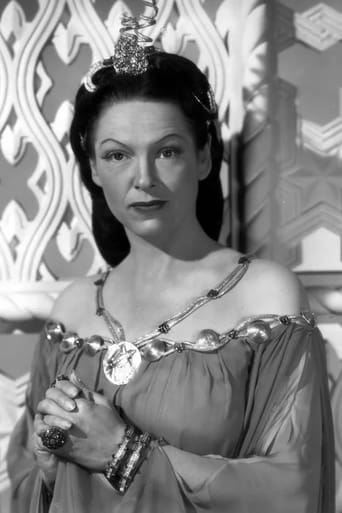Ameriatch
One of the best films i have seen
Stellead
Don't listen to the Hype. It's awful
Lollivan
It's the kind of movie you'll want to see a second time with someone who hasn't seen it yet, to remember what it was like to watch it for the first time.
Allison Davies
The film never slows down or bores, plunging from one harrowing sequence to the next.
SimonJack
This movie is based on a book by Margaret Landon in 1944. "Anna and the King of Siam" was a best-selling novel based on a true story. The story is much more interesting and intriguing than the movie can portray. And the true story within the story is more fascinating yet. So, how much of the movie is fact, and how much fiction? First, the film and then the background. The main characters are real, and played well. I don't hold with those who argue that a person of one race can't play a role of another race. That's part of what theater and acting are about. Sure, it's nice and best if one can find the talent and qualified actors to play various ethnic roles. But it's not necessary. And, I don't nitpick actors who don't look a part, or who's accents aren't perfect – unless they are quite terrible to the point of distraction.Rex Harrison does an excellent job as Mongkut, the king Siam. Lee J. Cobb is very good as Kralahome, his prime minister. He is probably the least believable as Siamese, and that's because his distinct voice, build and persona are so well known. But his acting, and broken English (as one might expect of a Siamese), are very good. Gale Sondergaard is so good in her role as Lady Thiang that she looks and sounds Siamese. Linda Darnell is almost as convincing as Tuptim.Now the background. Margaret Landon was an American missionary who served with her husband in Siam from 1927-1937. She taught here three children along with Siamese in a mission school in Trang. She studied and read all about the country. She learned about Anna Leonowens who had been a governess to the Siamese royal family in the 19th century. After Landon's family returned to the U.S. in 1937, she wrote the book about Anna. It was a best-seller in 1944, and 20th Century Fox made this movie in 1946. A decade later, her book also would become the source for the Fox musical, "The King and I." But how much of the book is true? And how much is the film true to the book, and the real life story? I didn't read the book so I can't comment on it. Another book about Anna came out in 2008 that gave a somewhat different background. "Bombay Anna" was written by Susan Morgan. It claims to tell "the real story and the remarkable adventures of the 'King and I' governess." A New York Times review of that book on Oct. 20, 2008, called Anna Leonowens a con woman. "On disembarking in Singapore as a young widow in 1859, this gifted con woman subtracted three years from her age, relocated her birthplace from Bombay to Wales, forgot her mother's Indian parentage, promoted her father from private to major and changed her husband from a clerk to an army officer." Leonowens was educated and knew languages – Hindi, Marathi, Persian and Sanskrit, and she could mimic a genteel English accent. She was Anglo-Indian and born Nov 6, 1831, in India. In 1849, she married an Irish clerk, Thomas Leon Owens. The two surnames later were merged. The couple spent several years in Australia where a daughter and son were born. First was Avis in 1854, and then Louis in 1856. In 1859, Thomas died of a stroke in Malaysia where he managed a hotel. Then Anna moved with here children to Singapore, where she revised her background to fit in among the expatriate British colony there.King Mongkut of Siam was born in 1804. He became a Buddhist monk and read and studied much. He helped establish a monastery that became the intellectual center of Siam. Mongkut became king in 1851 and reigned until his death in 1868. In 1861, he asked his agent in Singapore to find an English governess for his children. Leonowens got the job and arrived in Bangkok in 1862. She sent daughter Avis to England to school and taught Thomas along with the royal household. She later sent Thomas to England to finish his schooling, and after five years she left Siam for the United Sates. She later moved to Montreal, Canada, to be near her daughter, and she died there in 1915 at age 84.So, how much of the movie is true to history? Well, Anna didn't stay into old age when the king died. He was older than she and he died in 1868. In the U.S. she wrote her memoirs and was successful as a teacher and traveling on the lecture circuit. Her son, Louis, did not die from an accident in Siam. Mongkut did write to a U.S. president and offer elephants. But it wasn't Abraham Lincoln, it was James Buchanan (1857-1861), and it was before Anna arrived in Bangkok. Mongkut was a progressive leader who ensured liberal education for his sons. After his death, they began many of his reforms. There is much more about Siam, Mongkut, Anna and others that room doesn't allow to tell here.In one scene, Mongkut has summoned Anna in the middle of the night. He questions the Bible story of creation. Anna says "Your majesty, the Bible was not written by men of science. It was written by men of faith. It was their explanation of the miracle of creation, which is just as great a miracle whether it took six days or many centuries. I think science does not contradict the Bible. It has only made us more aware of how great the miracle was."
walkert8721
I have seen the King and I so I was anxious to see this movie: Anna and the King of Siam. I am also a huge Irene Dune fan. However, I am not sure if this movie was made for her sake, the USA sake or just plain the studios! The out right Caucasian supremacy and arrogance of Anna's character is ridiculous! So, a Caucasian woman just walked into another country and just told a king what to do and sashay out of the castle?! I mean really even in the USA at that time period she would NOT have acted that way to the President of the United States! Such disrespect would have never happened. I like her other movies much better or should I say I like the writing better in her other movies.
Nick Zegarac (movieman-200)
"Anna and the King of Siam" 1946 is the first big screen adaptation to borrow from the personal journals and public account of British school teacher, Anna Leonowens and her experiences in the far East. After the death of her beloved husband, Anna (Irene Dunne) departed England in 1862 with her young son in tow to become the educator of the King of Siam's many children. However, upon arrival, Anna discovers that King Mongkut (Rex Harrison) is very much a renaissance man trapped in heritage thinking. He refuses to acknowledge Anna's request for a house, expects that she will bow and grovel as his servant, and demands, above all else that the protocol of suppliant be strictly observed. The headstrong Anna, of course, disagrees. And although their initial meeting is marred by a considerable clash of wills, eventually the two begin to recognize a genuine affection and respect for one another. He, in marvel of her forthright nature in the face of his wielding totalitarianism, realizes his way may not always be right. She, in absence of having a man to love, discovers a fallible side beneath the king's rather gruff façade. Together these two launch a formidable quest to bring western culture and change to the seemingly backward status of Siam. However, the revolution will neither be easy nor straight forward.Director, John Cromwell does his very best to ensure an integrity in what are essentially cardboard caricatures of people who perhaps defy any three-dimensional understanding. In point of fact, Anna Leonowens probably overestimated her influence on the country and its monarch in her journals. Hence, the whole tale is thrown off balance by a very traditionalist and imperialist perspective that reduces Mongkut to parody from the start. As a Siamese king, Rex Harrison is hardly ideally cast – yet he manages to make much of the shortcoming, transforming what might otherwise have been a very dismal characterization into a challenging bit of reflection. Irene Dunne is an effervescent Anna – though in her, one sees perhaps too much of the screwball heiress a la Cary Grant in "The Awful Truth" and less of the stalwart schoolmarm that was, in fact, the real Anna Leonowens.Fox's Studio Line transfer on "Anna and The King of Siam" is impressive, if flawed. Though dirt, scratches and grain are kept to a bare minimum, there are still occasions riddled throughout, where the gray scale falters. Blacks are sometimes black, sometimes deep gray. Whites can be clean, but most often appear slightly speckled. Contrast levels vary throughout. There's some speculation as to whether dupe negatives were used for certain scenes. There is a genuine loss of fine details in certain scenes. The audio is mono but nicely balanced. The only extras are an audio commentary and a Biography Special on the real Anna Leonowens.
dmsorge
In reading the comments about "Anna and the King of Siam,"I was especially drawn to the harsh political commentaries by your reviewers.When I was saw the film in the summer of 1946,the war was over only eleven months,and I was feeling generally upbeat.Consequently,watching this film,I felt upbeat about it,too.I thought then,and I still do(seeing it on tv),that it was a beautifully produced picture.One thing I noted at the time of its release,was that movie reviewers universally criticized Twentieth Century-Fox for not filming it in Technicolor.(Fox didn't repeat their mistake in their musical production with Yul Brynner and Deborah Kerr.)Their 1946 film garnered the Oscars for black and white cinematography, and black and white art direction, and interior decoration.(Costume design nominations didn't arrive until 1948--"Hamlet,"b&w,and "Joan of Arc,"color,won).If costume design had been a factor in 1946, I'm dead sure "Anna and the King of Siam" would have been a shoo-in.The musical version in 1956 did get the prize.Irene Dunne had a spate of fine film from 1936 to 1948,and this was leader among them.I can't imagine another actor living in 1946 playing the king.(Mr.Brynner appeared on the scene in the stage production around 1950.After that,he went to Hollywood).Gale Sondergaard received an Oscar nomination for Best Supporting Actress.John Cromwell's direction was as artful as his work with "Since You Went Away."in 1944.For this film:A rating of A.








